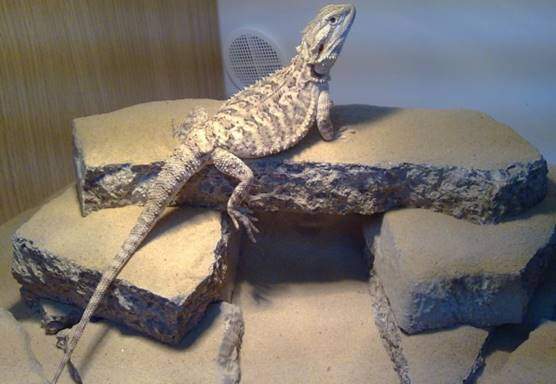The ‘Pogonas’ or bearded dragons belong to the genus Pogona under the family Agamidae, which has eight different species, with some sources noting nine species.
They get their name from their beard-like structure (glutaral pockets) beneath their throat that blackens for various reasons, including when agamid lizard is under stress, being aggressive, trying to communicate, and so on.
As exotic pets
Although Australia banned the sale of any of its wild animals as pets in the 1960s, there is an increasing growth in people who keep these agamid lizards.
The most popular species of Pogonas kept as a pet or exhibited at shows is the central bearded dragon (Pogona vitticeps). Some people also hold the Rankin’s dragon (Pogona henrylawsoni) and the Eastern bearded Dragons as a pet, but it is not as popular Pogona vitticeps.
General appearance and description
All the members of genus Pogona, like other lizards in the subfamily Amphibolurinae have the following features:
- A Wide triangular-shaped head and a flat body
- Spiny scales around the back of their head and on throat arranged in clusters and rows.
- Male grow larger than females
- Each species has certain lengths to which they grow with the largest growing up to 64 cm.
Where they live or natural habitats in the wild
The different species are found all over Australia in varied habitats mainly arid, subtropical, woodlands such as eucalyptus woodlands, savannas, scrublands, interior deserts and shore, islands, near areas inhabited with human beings
Their natural habitat extends throughout the interior of the eastern states to the east half of South Australia and the southeastern Northern Territory. (1)
Let us look at the various Pogona species.
Pogona vitticeps – Inland or central bearded dragons
The Pogona vitticeps is native to rocky deserts, dry forest, semiarid, and arid woodlands of Central Australia, especially in areas such as Queensland, Victoria, Northern Territory, New South Wales, as well as parts of South Australia.
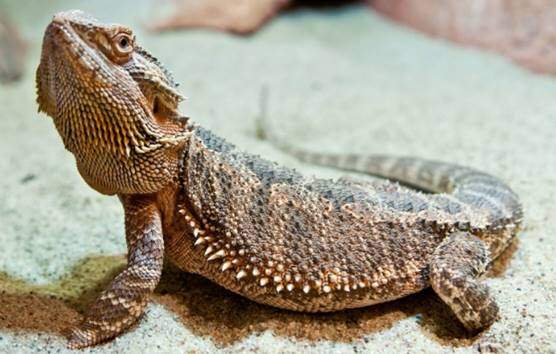
As skilled climbers, they often perch on small tree branches, dead vegetations including spinifex grass hammocks, fallen trees, fence posts as well as bask outcrop rocks, and when it is hot, they will retreat to grasslands and colder areas including burrows.
These agamid lizards are by far the most popular one kept as a pet or exhibited in shows and zoos, and the term ‘bearded dragon’ in the context of exotic pets is synonymous to Pogona vitticeps.
1. Quick facts
- Size and weight – They are large Pogonas that grow up to 16 to 24 inches (40 to 61 cm) in length from tail to head and weigh 350 to 600 g.
- Average lifespan – Their average lifespan in captivity is 10-12 years but can live up to 14 years with the oldest living having lived for 19 years and five months in captivity. (1)
- Not highly dimorphic – Male and females look alike with the difference been males have a more substantial beard, prominent femoral pores as well as wide cloacal opening and tail base due to the presence of hemipenes.
- Temperament – Docile and mellow, but juveniles and babies can be skittish. However, their temperate and personality do vary.
- Breeding – They breed during summer and spring. A female Pogona vitticeps can lay clutches of up to as many as 24 eggs, and they take 55-75 days to hatch at 28.9 degrees Celsius.
2. Description and appearance
At times referred to as Amphibolurus vitticeps, they come in various colors, including red, white, orange, brown, reddish-brown, and so on with selectively bred bearded dragon morphs have different skin textures, colors, and patterns.
If beardies interest you, and you want to know more, below is a summary with links where you can get any information you may need.
- Bearded dragons: Has an overview that will open your world to these pets.
- Behaviors: Typical beardie behaviors like head bobbing beard display, arm-waving, gaping as well as others like digging, surfing, and so on
- Breeding and gender: Has insight on such as breeding, sexing, age and size
- Pet bearded dragon: Answers whether they are good pets, including where to buy them, how much they cost, how much it costs to have them, and much more.
- Housing: terrarium types, best tank sizes, and housing them together.
- Supplies and enclosure set up: UV lights, heat lamps, substrate, thermometers, hygrometers, thermostats, screen covers, food bowls, water bowls, and more.
- Décor and furniture: Hammocks, basking platforms, climbing branches or logs, live and artificial plants, terrarium backgrounds, etc.
- Health – common disease and conditions like metabolic bone disease, mouth rot, tail rot, as well as signs and symptoms of illnesses.
- Diet and food: How to feed babies, juveniles, and adults as well as foods they eat, including feeder insects and bugs, veggies, fruits, safe plants, herbs, and so on.
- Extras: Extras include costumes and outfits like cowboy hats, Santa hats, shark costumes, wizards costumes, toys, as well as harness and leash.
- Morphs: Typical bearded dragon morphs on sale.
- Care – You will learn how to care for your bearded beardies, including bathing it, cleaning his vivarium, and much more on care and husbandry.
Pygmy or Rankin’s Dragon – Pogona henrylawsoni
Named Henry Lawson, a famous poet, and author, Lawson’s or Rankin’s dragon is native to the drier and hot areas of Queensland in Australia with sandy clays, succulent plants, cacti, and scrubland plants. However, they also available in other parts of the world living under captivity
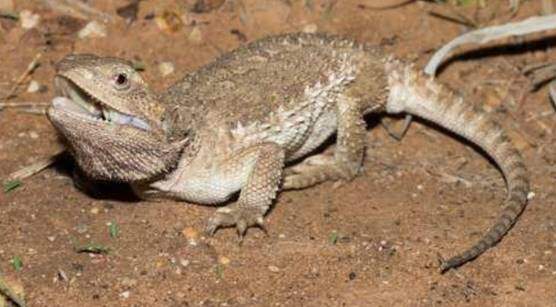
P. henrylawsoni has other names that include a pygmy dragon, bearded dwarf dragon, solid black dragon, or dumpy dragon with some classifications using the Pogona brevis synonym to refer to this reptile.
Like other Pogonas, while in its natural habitat basks on outcrop rocks, broken trees, or tree branches but will go to burrows when temperatures are extremely high.
1. Rankin’s dragon quick facts
- Full size – The average size of grown-up adult Rankin’s dragon is 8-12 inches (20-30 cm) long from snout to tail and weigh 60 to +100 grams.
- Lifespan – The average lifespan of the Rankin’s dragon is 6-8 years but can live for 10-15 years with proper care in captivity.
- Similar breed – Central bearded dragon.
- Breeding – Females lay 5-18 eggs, 2-3 weeks after mating. Eggs hatch after 48-56 days at 31°C. While in the wild, they are reproductive between August to February.
- Temperament – They Docile and sociable and accept handling. However, juveniles may be skittish.
2. Appearance and description
When compared to the central bearded dragon, it closely resembles it. However, it is smaller in size.
Furthermore, they are slightly darker colors giving them excellent camouflage and are less textured. However, these lizards have more patterns, especially on their backs, where they may have a combination of brown, green, or gray ones, while their tails have strips with two colors.
Besides their rounder head, narrower neck, and less prominent beard with lesser and smaller spikes, they are more active hence higher appetites and are very social, making them suitable for even kids.
Finally, since they are more social, you can house Rankin’s dragon together in social groups. However, males will tend to display dominance as a means of establishing hierarchy.
3. Living in captivity
While in captivity, what they require is more or less what central bearded dragon requires, including care, diet, specific preferred temperature, UV light, substrate, and so on. Here is a summary:
- Housing – They need dry, warm, well-ventilated vivarium or terrarium, including the glass, wooden, acrylic, plastic, PVC cages, among other types of terrariums.
- Tank size – Buy at least a 40-gallon tank habitat. However, a large one such as a 4 x 2 x 2ft since they are more active. Such a cage will be ideal for creating a temperature gradient. i.e., a hotter side with heat lamps and a colder side. Don’t forget their furniture.
- Supplies – since they thrive in a hot, dry habitat that closely mimics, you need heat lamps, UV light source, a substrate, décor and furniture, thermostats, thermometers, hygrometer, and other typical supplies for beardies.
- Diet – Omnivorous diet similar to that of Pogona vitticeps and is made up of mainly live feeder insects like crickets, roaches, worms, as well as some veggies and safe plants. Do not forget to give them water.
- Supplements – Calcium and multivitamins.
4. Rankin’s dragon for sale and price
If interested in them, you will find them in rescue centers, pet stores, shows, breeders, or places. While online, look for them at Tiki’s Geckos, lllreptile.com, Reptilecity.com, Morphmarket.com, Preloved.co.uk, etc.
Their prices will range from as low as $75 to as high as +$200 depending on where you buy them.
Eastern Bearded Dragons – Pogona barbata
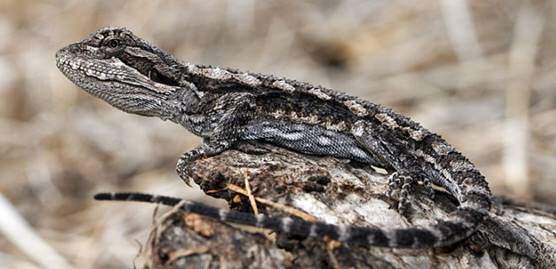
This agamid lizard is native to dry woodlands and open forest in New South Wales, Australian Capital Territory, Queensland, Victoria, and South Australia woodlands, especially the eastern parts of the Cape York Peninsula.
Thye goes by other names include Jew lizard, bearded lizard, coast bearded dragon, the common bearded dragon, and frilly lizard. However, don’t confuse them with frill-necked lizards that belong to the genus Chlamydosaurus.
Like other Pogonas, they are semi-arboreal and love perching on exposed logs, branches, or rock outcrops but retreat to cooler areas when the sun is sweltering.
1. Quick facts
- Size – Fully grown male adults can grow up to 60 cm (24 in) while females grow about 50 cm (20 in) from tail to snout, and they have an average body mass of 350g.
- Behavior – They are aggressive and territorial than vitticeps. Male don’t permit females or juveniles in their territory and the largest (and dominant) perch on the highest basking place. Finally, they show their beard more often and open their mouth when provoked.
- Breeding – after breeding, females burrow and lay a clutch of between 14 and 31. Eggs hatch after 75-84 days at 25°C. While in the wild, they lay eggs between August and December.
- Lifespan- They live for 6-10 years under captivity, but this lifespan may be shorter in the wild, owing to the threat of predators, weather, and other factors.
2. Description and appearance
They have a large triangular head, dorsoventrally relatively flat and slender abdomen, and the thorax. Their body is less robust and has spines on their body’s edge, beginning from their arms going laterally down to their hind legs.
Furthermore, they have dark grey spiny scales on their neck area that makes a great beard if inflated. Some have much “longer spiny scales are located at the back of the head, the corners of the mouth, the external ear openings, and running posteriorly along both sides of the abdomen.” (1)
Their skin is predominantly is grey-black or red. However, it is sometimes yellowish-brown, dark brown, or reddish-brown.
Juveniles are born with paler colors and patterns that fade as they grow while the foreparts of their head will become subtle blue, yellow, or have a green hint as they mature.
When at higher temperatures or excited, their leg, flags, and head become orange or yellowish from their usual dark, i.e., have darker shades of yellow, grey, or black.
When compared to inland beardie, another distinction the bright yellow color of their mouth lining, unlike the reddish-pink hue that the inland beardies have.
3. In captivity
While not one of the most kept exotic pets, there are people who have them. In the wild, they tend to be insectivorous while young, and as they grow into maturity, they become omnivorous but also eat other smaller reptiles, insects, mice, beetles, katydids, snails, and so on.
Besides feeder insects, you can give them veggies, fruits, berries, flowers, and so on.
Pogona microlepidota or Kimberley Bearded Dragon
The Pogona microlepidota, Kimberley, or small-scaled Bearded Dragon is native to Western Australia, especially in Drysdale River Mission Park in the northern corner of Western Australia and North Kimberley. These lizards are commonly found on woodlands where spinifex grasses grow and in lowland shrubs.
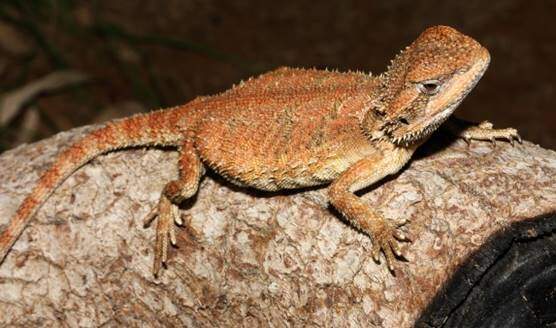
They are relatively larger s when compared to the Pogona henrylawsoni with a head that is small and narrow, and their bodies are depressed.
Not to confuse it with the P. minor, this agamid lizard has 3-5 spines rows on their dorsoventral area running from their arms to hind legs a not the one raw that the P. minor has on his
On average, Pogona microlepidota can grow up to 45 centimeters and has an average weight of about +130 grams.
Finally, it is not easy for you to get the Kimberly bearded dragon in the pet trade, but they are widely available for sale.
Dwarf bearded dragon – Pogona minor
The Dwarf or western bearded dragon or P. minor has two subspecies, i.e., Pogona minor minor that is more widespread in Western Australia and the slightly smaller Pogona minor minima only found in Wallabi Group of islands.
The most different things about these species are their shorter limbs as well as tail.
1. Pogona minor minima (P. m. minima)
Also known as Abrolhos bearded dragon or Abrolhos dwarf bearded dragon, this agamid lizard is native to North Island, East Island, and West Wallabi Island, the three islands that make the Wallabi group of Islands.
It grows up to 36 inches from tail to snout and you will commonly find it on outcrop limestone rocks or sandy habitats
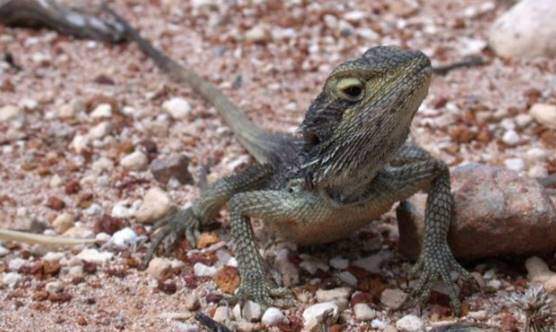
2. Pogona minor minor (P. m. minor)
This subspecies is widespread throughout the southwestern all through to the central deserts of Australia. They have a chameleon-like color that brightens when interacting or blends to their environment.
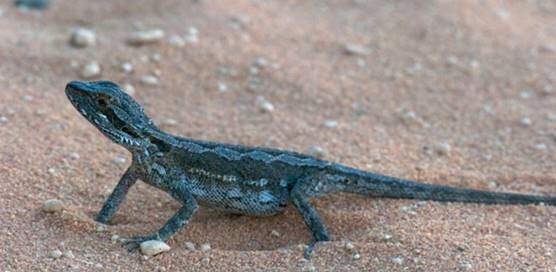
Measuring about 38 cm (15 inches), they look like the mulga dragons and Pogona Nullarbor. However, their heads are smaller, and their spines positioning on their neck and underside varies.
Finally, they display typical Pogonas behavior like arm waving, head bobbing, and so for the same reasons, other members of this genus show these behaviors.
Western bearded dragon – Pogona minima
First described by Loveridge in 1933, the Pogona minima is also a Western Australia beardie found on the southwestern parts. This large (grows up to 20 inches) agamid lizard’s typical habitats include semi-arid areas like heathland or woodlands, coastal dunes, and arid deserts.
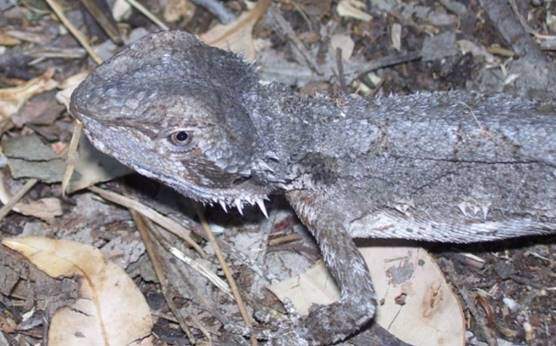
They love basking on rocks, fence posts, fallen trees, and roadways (which is dangerous for them as they are by vehicles).
Pogona minima closely resemble the P. mitchelli, but their heads don’t have robust head spikes that form a conical shape. Similarly, they bear a resemblance to the P. m. minor, but they have longer legs and their tail and are a little slender.
Finally, they breed during October and February and have one or double 4-15 egg clutches.
Pogona mitchelli or Mitchell’s Bearded Dragon
The P. mitchelli is native north-western Australia, especially in Pilbara and its surroundings. This lizard lives in varying habitats, such as dry woodlands, scrublands, and the Great Sandy Desert. Some classification considers it as a subspecies of the P. minor, i.e., P. minor mitchelli, while others take it as its type of species.
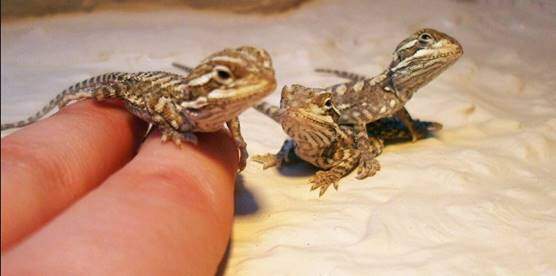
This beardie has more brownish and less graying when compared to P. m. minor making its coloration brighter. Furthermore, it is larger, with a broader head, and lacks longitudinal scales along its nape side.
Typically, this reptile lays eggs between March and May, and its eggs will hatch after 49-51 days at 30-31°C.
Finally, if you are interested in buying this Pogona species, it is not available for pet trade anywhere else.
Pogona nullarbor or Nullarbor bearded dragon
The Nullarbor bearded dragon is a medium-sized agamid lizard that commonly lives in south-central Australia, particularly on the Nullarbor Plains in various habitats as well as the coastal area, in caves as well as on stiff cliffs.
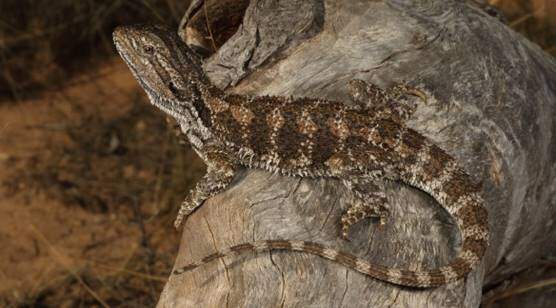
What makes Pogona nullarbor unique is its white bands on its back, i.e., on its tail and neck areas as well as 3-7 rows of spines along its body sides, i.e., on its lateral fringe. Also, its much-depressed broader body, and short snout, and tail.
Finally, as the smallest among the Pogonas, it has an average weight is 64 grams, and it is not available for the pet trade.
Vittikins Bearded dragon
The Vittikins beardie is not a species but Henry’s hybrid between the Henry Lawson’s dragons and Pogona vitticeps
